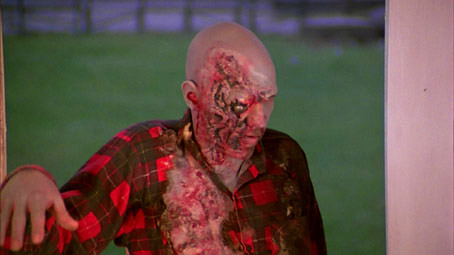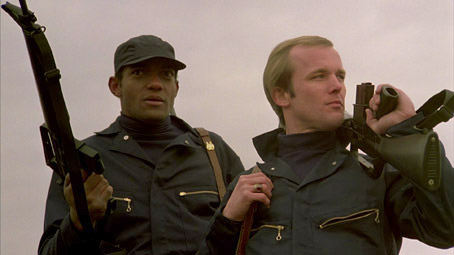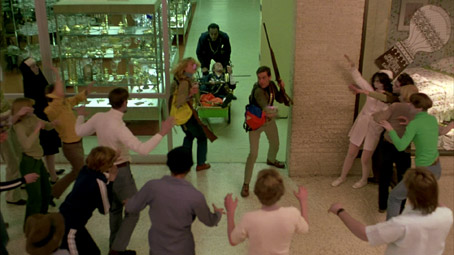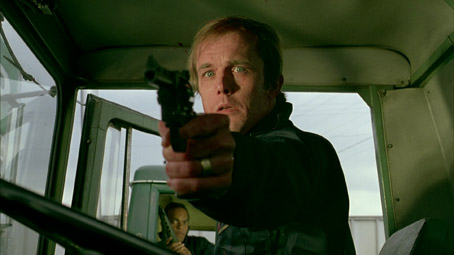|
I was working in one of the least satisfying jobs I've ever had when George Romero's Dawn of the Dead – or Zombies as it was titled here back then – was released in UK cinemas. The one plus of that particular workplace was the earthy humour of my young workmates, who although bemused by my devotion to non-mainstream movies would just occasionally watch a film solely on my recommendation. Dawn of the Dead was one such title. Needless to say I loved it – was there a horror fan alive at the time who didn't? – but I was unsure how my comrades would react. They'd relish the gore, of that I was certain, but would they get the humour or the social commentary? Would they become bored between the bouts of violence and chasing about? I thus awaited their reaction with some trepidation. It was delivered the next morning not as a verbal assessment but in the manner of their arrival in an instantly recognisable rigor mortis walk accompanied by a loudly hummed slice of comical elevator music that the film had made its own. Oh yes, they got it all right.
There have been some claims made recently, usually by younger horror fans for whom 1980 is ancient history, that Dawn of the Dead hasn't dated that well and that Zack Snyder's 2006 remake is somehow superior. Not wanting to dismiss the views of others on what is unquestionably a personal call, but like hell it is. One thing it's important to remember about anyone looking to remake a well loved original is that no matter how slick the results, they are still effectively standing on giant's shoulders, and that a sizeable portion of their work has already been completed by others before a word of any new script has even been penned. Creating something original, truly original, requires an extraordinary melding of skills, hard work and good fortune, in the writing, in the visual realisation, in the casting and in the securing of funding, and a whole lot more. It also requires people to take a chance on something, to invest their time and money into a project that may never see the light of day, let alone find an audience. I've no wish to denigrate the considerable work put in by those who work to bring any film to the screen (I know from personal experience how hard that can be), but a remake simply does not involve the same level of creativity and risk as the original that spawned it because the blueprint has already been drawn up, the product successfully road tested, the brand name established and the audience pre-primed.

According to director George Romero, he had never planned to make a sequel to his groundbreaking debut feature Night of the Living Dead, but was contacted by Italian giallo maestro Dario Argento about the possibility of doing so only a short while after a trip to a shopping mall first planted the idea in Romero's head. A deal was struck that provided initial funding and gave Argento the right to produce his own cut of the film for the European release. What evolved was not a sequel to Night but a follow-on, a development of its ideas and themes wedded to contemporary social issues within the framework of what was to become Episode 2 of perhaps the genre's most celebrated trilogy – whether Romero's subsequent zombie films remain a three-part postscript or expand the trilogy into a fully fledged hexology is a matter of divided opinion.
Dispensing with the brief character prologue of its predecessor, Dawn kicks off with the world already in crisis – the dead have risen and are attacking the living in a battle that humankind is showing the first signs of losing. Sketchy details are being outlined by an interviewed scientist as the television studio around him collapses into pandemonium (and yes, that's Romero as the TV director trying to keep his broadcast in order), while in the city outside SWAT officers raid a tenement block and engage the undead in combat. What should be a one-sided fight – the soldiers are armed with automatic weapons, after all – proves to be anything but. Turn your back on a corpse and it'll take a bite out of your arm or crawl towards you and chew on your leg, and anyone bitten by a zombie is quickly transformed into one themselves.
Looking to get out of the city while they still can is helicopter pilot Stephen, his girlfriend Fran and his close friend Roger, a SWAT commando who invites newly met comrade Peter to join them. Tired and low on fuel, the four set down on the roof of a large shopping mall, to which they gain entry through a skylight. Here they rest up and stock up on supplies, barricading themselves in a storeroom and playing hit and run with the zombies to gain access to the mall's shops and their contents. Realising they might be on to a good thing, they decide to hold up for a while and plan their next move.
There's a distinct tonal shift from the first film here, with the apocalyptic chaos of the opening scenes signalling a move towards a more action-oriented approach in which the horror underpins the narrative and provides the motivating threat. That's not to say it's pushed into the background, no sir. On the film's release, Tom Savini's grisly makeup effects – which include chucks of flesh being bitten from arms and necks, the top of a head lopped off by a helicopter rotor blade and a body being torn apart in front of its horrified owner's eyes – were a bit too much for the British censor, who only passed the film for general release after some of the more graphic effects shots had been trimmed. Subsequent refinement of the make-up effects art has left a few of the tricks here looking a little transparent by today's CG-assisted standards – the built-up head for the helicopter gag turns the zombie in question into a Frankenstein monster – but back in the late '70s this was groundbreaking stuff and has retained a good deal of its power to both surprise and disturb due to the context in which it is used.

But Dawn is as smart as it is visceral. From the moment the group enter the mall we're in social satire territory, as the zombies stumble about to piped muzak like dozy Christmas shoppers on automatic pilot, drawn instinctively back to what was "an important place in their lives" and occasionally indistinguishable from the showroom dummies they now ignore in favour of their living equivalent. The mall itself becomes a microcosm of American consumerism, a source of supplies for a group that over time becomes seduced by the easy pleasures that free access to such a wide range of material goods can offer. Only late in the film, as they dress for dinner, smoke cigars and enjoy fine wine with their meals, do they question what they've become, citizens of a gated community enjoying life's shallow comforts while the murderous proletariat are kept safely distanced by weapons and physical barriers. Viewed from this perspective, the zombies really are looking to eat the rich, and it seems only appropriate that this false sense of security is shattered by a group of anarchic bikers, revolutionaries without a cause who run riot in the community and attempt to bag the territory for themselves. This violent disruption of the status quo brings an end to the group's cosseted existence and breaks down their imposed social structure in a manner that allows the society itself to self-destruct.
Where Dawn really does part company with its predecessor is in its flashes of humour, which range from a string of small but memorable character moments (the sight of Stephen and Peter following the ribboned queuing route to empty a bank of its counter cash has always amused me) to the hilariously upbeat muzak, particularly H. Chappel's 'The Gonk', a tune that is almost guaranteed to get fans of the film stumbling around with stiffened legs and outstretched arms. Romero may push his luck a little by having the bikers hit the zombies with custard pies, but it's very much in the spirit of their rampage – for them the zombies are little more than arcade amusements and the threat they represent has yet to turn round and bite them.
If you're coming to Dawn of the Dead for the first time from a modern horror perspective, then it's important to remember that all of those zombie films you've seen since its release are effectively bastard offspring of Romero's original. Night of the Living Dead helped shape the modern horror film as we know it today, but it was Dawn of the Dead that defined the structure and content of zombie sub-genre as it would play from this point on. The cool thing, the really cool thing, is that unless you're a modern CG effects junkie, the film doesn't have to put into historical context to shine, thanks to a tightly structured and intelligent script, convincing and pleasingly understated performances, Romero's spot-on camera placement and dynamite editing, and the multi-layered subtext that's as potent and relevant as it ever was – as Christmas looms, you only need to take a trip to your local superstore to witness for real Romero's image of a dazed populace shuffling around the aisles of its new consumerist church. Dawn of the Dead may not be as unremittingly tense and disturbing as its predecessor – nor was it ever intended to be – but in all other respects it's everything a great horror movie should be and a whole lot more besides. It's a work of considerable substance and style whose density of ideas and immaculate execution have left their indelible mark on all subsequent zombie movies, none of which have come close to equalling the inventiveness, social awareness and sense of fun that Dawn of the Dead has in spades.
Three versions of the film have been included in this set, the theatrical cut, a so-called director's cut and one prepared by Dario Argento for the film's Italian release. While it's interesting to see the alternative edits, I'll go with the theatrical cut every time, particularly as we're talking the full version rather than the one trimmed by 3 minutes 46 seconds by the BBFC for its UK cinema release (a further 12 seconds were lost from the subsequent video version). Apparently this is also Romero's preferred version, something recognised here in its selection for Blu-ray treatment, while the other two are on standard def DVDs.

The director's cut is nothing of the sort but a version prepared for screening at Cannes that's pretty much the theatrical cut before its editing was tightened for general release. The Argento cut, on the other hand, really is an alternative edit: it's shorter, more action-oriented, and is stripped of most of the original's humour. The music scores on both are credited to Argento faves Goblin, but the subtle effectiveness of their contribution to Romero's version is traded in on the Argento cut for something louder and brasher that's a long, long way from the group's sublime work on Argento's Suspiria. Even the muzak here is disappointing, lacking the satirical element and stick-in-the-brain catchiness of the Romero tunes.
The star prize here and the key selling point of the set is the Blu-ray transfer of the theatrical cut. Now put the words 'horror', 'low budget' and '1970s' together and I almost instinctively lower my expectations for the picture quality, but this transfer certainly put me in my place. It really does look rather lovely here, with the sharpness and picture detail up there with some of the better high budget transfers of late, with the usual favourites of facial close-ups, textured clothing and metallic surfaces coming off the best. Colours are bright when they need to be (the helicopter paintwork is a good example) and naturalistic in the right lighting, though many scenes have a brown/green hue that may well be down to location lighting and/or colour balance on the original neg. Grain is barely visible and the transfer has a very pleasing 'filmic' look that's just not as pronounced on the DVD versions. It is a touch on the dark side, but this has apparently been an issue with prints for some time and does not serious harm to what is an otherwise excellent job.
As far as soundtracks go, there's a choice between 2.0 LPCM stereo and 5.1 DTS HD Master Audio, both in the original English. The stereo track is closer to how the film originally played, but the DTS track appears to be a legit remix, with a crisper clarity and distinct separation in places, although both tracks spend most of their time at front and centre.
The standard def anamorphic transfers of the other two cuts are of a similar quality but at a lower resolution and appear to be NTSC to PAL conversions, albeit good ones. Unlike some other dual format releases I've seen, you don't need to do a side-by-side comparison to spot the difference – the Blu-ray transfer is a serious step up from its DVD counterparts. Compression artefacts are occasionally visible on the DVDs, but usually confined to large areas of single colour.
The soundtrack is Dolby 2.0 stereo track is clear enough, but the DTS track on the Blu-ray definitely has the edge.
English subtitles are provided for all three cuts and, in a move I always applaud, for both commentary tracks.
Disc 1 – Blu-ray
Audio Commentary with writer/director George Romero, make-up effects artist and actor Tom Savini and assistant director Chris Romero
A lively commentary, moderated by Perry Martin for Anchor Bay's 2004 4-disc Ultimate DVD edition, that provides a wealth of detailed and revealing background information and covers a lot of ground, including the make-up effects, the Argento cut, the lighting, the social and subtextual elements, the biker raid, the original ending, and a whole lot more. There's an interesting discussion on the merits or otherwise of CG, and Chris Romero (who played the title character's cousin Christina in Romero's brilliant 1977 vampire movie Martin and subsequently married the director) thought at the time and still thinks today that the pie fight was the silliest thing she'd ever seen. There are plenty of entertaining anecdotes – I particularly enjoyed the story about the zombie extras who photograph themselves in full make up using the mall's photo booth and then use the resulting pictures to replace the demo pictures of smiling family types on the booth's exterior. A startling indication of how times have changed, even for enterprising indie filmmakers, comes with the revelation that Romero and his crew were not just given permission to shoot in a real shopping mall, but effectively handed the keys to the whole place at night and given free reign to go almost anywhere they wanted, with only a skeleton security crew provided to watch over them.

Audio Commentary by producer Richard P. Rubenstein
Also moderated and effectively fed by Perry Martin for the same Anchor Bay DVD release, this is a worthwhile companion to the above, with Rubenstein's openly confessed lack of artistic input to the project giving him a different perspective on the production to Romero and his colleagues. Inevitably there's more emphasis on the budgetary and business elements, but these are a lot more interesting than you might expect, and he also covers aspects of the production itself, including the genesis of the project, Romero's directorial style and lack of business acumen, the working environment ("controlled chaos"), the specifics of using the mall, and the success the film enjoyed following its release. Things slip a bit in the later stages as Rubenstein gets a little touchy about the negative reaction to the prospect of the remake, which he was then in the process of co-producing, and gets a little bogged down in promoting the new film and the talent involved, though frankly his description of the scriptwriting process made it sound even more like committee-led moviemaking than I'd previously feared. He also gets on the case of the fans who have used images and clips from the film on their web sites without permission – the point is valid, but made at tiring length.
Disc 2 – DVD
The Dead Will Walk (74:55)
A comprehensive, informative and thoroughly engaging retrospective documentary on the making of Dawn of the Dead that tells the story of its production through interviews with many of the key personnel involved, including Romero, his wife and assistant director Chris, DoP Michael Gornick, editor Pascale Buba, makeup effects wizard Tom Savini, co-producer Dario Argento, all of the main cast and a good few of the minor supporting players, who worked, in the words of one of them, "for a dollar and a doughnut." There's inevitably some crossover with the first commentary, but the sheer number of contributors here provides a wider perspective and a further selection of anecdotes, and there's even some on-set behind-the-scenes footage included. It certainly sounds like a great project to have been involved in – actor Ken Foree (who plays Peter) is particularly enthusiastic in his recollections, while Savini tellingly states that afterwards "life was so boring compared to being on the set of Dawn of the Dead."
Disc 3 – DVD
Scream Greats – Tom Savini (52:42)
The first of a Fangoria video magazine series on key figures in horror cinema focuses on the always energetic Savini. A comprehensive and enjoyable piece that's littered with extracts of Savini's film work, the star attraction is inevitably Savini himself, particularly the footage of him at home with family and friends, where he has a fencing match on the roof, balances his upright baby on one hand (honestly, you have to see this one) and rigs his wife up with exploding squibs but forgets to provide her with ear plugs.
Also included are the US Trailer (2:37), which soberly describes the film as "a horrible, hauntingly accurate vision of the mindless excesses of a society gone mad," the German Trailer (0:58), Radio Spots (2:23), TV Spots (1:28), five reviews of the film (including one by Stephen King), and three trailers for Arrow's first Masters of Giallo DVD releases.
Non-disc extras
Inside the case are a Booklet containing an excellent essay on the film by author and critic Calum Waddell and a fold-out reproduction of original posters for both Dawn of the Dead and Zombies, the latter being the exact size and design of one I begged from the local cinema manager on the film's initial UK release. The packaging is also a small joy, and is arranged in such a way that you can choose between four different covers.
A great, great horror film infused with a smart and multi-layered social commentary (which I've only touched on above), and whose style and effects were to set the standard and future direction for the genre as a whole. Its influence has been huge and is clearly visible on just about every subsequent zombie movie, as well as pretty much the entire Survival Horror genre of computer games. Currently only available from HMV (there's been a lot of this recently) but due for a wider release on 1st March 2010, Arrow's 3-disc set includes some but not all of the extras from Anchor Bay's 4-disc Ultimate Edition, with no sign of Roy Frumkes' making-of documentary Document of the Dead or the cast commentary featuring lead players Ken Foree, Gaylen Ross, David Emge, and Scott Reiniger. But the included extras are still top notch and the quality of the Blu-ray transfer on the theatrical cut justifies the purchase alone. Wherever you decide to buy it, it comes highly recommended.
|